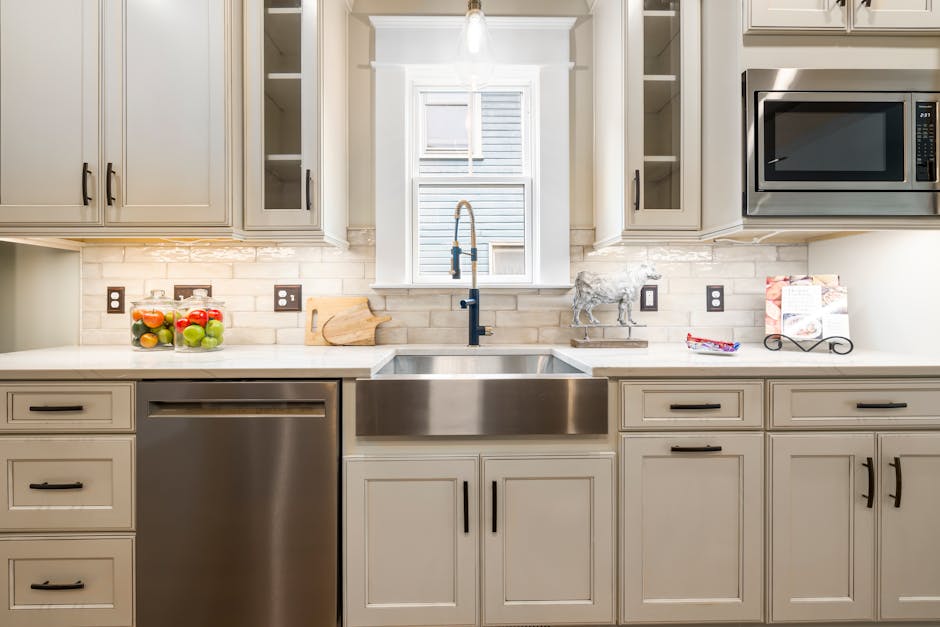Remodeling a kitchen that opens into a split-level living room presents a unique set of design challenges and opportunities. It’s not just about replacing cabinets and appliances; it’s about creating a cohesive and functional space that seamlessly integrates the kitchen with the distinct character of a split-level home. The split-level design, popular in the mid-20th century, often features staggered floors connected by short flights of stairs, which can complicate the flow between the kitchen and living areas. But these challenges can be overcome with careful planning and thoughtful design choices. You can create a open kitchen remodel.
Understanding the Split-Level Layout
Before you even think about picking out new countertops, you need to thoroughly understand the split-level layout and how your kitchen interacts with it. These homes, characteristized by their staggered floor plans, often create visual and physical barriers between rooms. Consider these factors:
- Traffic Flow: How do people move between the kitchen, living room, and other areas of the house? Are there bottlenecks or awkward transitions? Is it a pain to get to the kitchen?
- Sightlines: What can you see from the kitchen? What can you see from the living room? Are there any views you want to enhance or block? Where are your sight lines directing attention?
- Ceiling Heights: Split-level homes often have varying ceiling heights, which can affect the sense of spaciousness. Take actual measurements.
- Natural Light: How much natural light does the kitchen receive? How does that light affect the adjacent living room? Is there a way to maximize light flow?
- Load Bearing Walls: Is the wall between the kitchen and living room load-bearing? Removing or altering it will require the expertise of a structural engineer and probably a permit.
Planning Your Kitchen Remodel
Careful planning is crucial for a successful kitchen remodel, especially when it involves an open layout with a split-level living room. Lets break this down into something digestible.
Defining Your Goals and Budget
What do you hope to achieve with your kitchen remodel? Are you primarily focused on aesthetics, functionality, or both? Establish a clear budget that accounts for all expenses, including materials, labor, permits, and unexpected costs. It's always good practice to add a buffer of 10-15% for those unexpected things.
Creating a Functional Layout
The kitchen layout should be optimized for workflow and efficiency. Consider the "kitchen work triangle" – the relationship between the sink, refrigerator, and cooktop. Aim for a layout that minimizes steps and maximizes counter space. Consider the following layout options:
- Island: A kitchen island can provide additional counter space, storage, and seating. It can also serve as a visual barrier between the kitchen and living room, defining the space without completely closing it off.
- Peninsula: A peninsula is similar to an island but is attached to a wall or cabinet run. It can be a good option if you don't have enough space for a full island.
- U-Shaped: A U-shaped kitchen provides ample counter space and storage and is well-suited for larger kitchens.
- L-Shaped: An L-shaped kitchen is a versatile option that can work well in smaller spaces. It's actually pretty common.
Choosing Materials and Finishes
Select materials and finishes that complement the style of both the kitchen and the living room. Consider the following:
- Cabinets: Cabinet style can range from traditional to modern, and the finish can have a big impact on the overall look of the space.
- Countertops: Countertop materials include granite, quartz, marble, and solid surface.
- Backsplash: A backsplash can add color, texture, and visual interest to the kitchen.
- Flooring: Flooring should be durable, easy to clean, and compatible with the style of both the kitchen and living room.
- Appliances: Choose appliances that are both functional and aesthetically pleasing. Stainless steel is a popular choice, but other options are available.
Bridging the Gap: Integrating Kitchen and Living Room
The key to a successful open kitchen remodel in a split-level home is to create a sense of continuity between the kitchen and living room.
Consistent Design Style
Maintain a consistent design style throughout both spaces. If your living room has a modern aesthetic, carry that style into the kitchen with sleek cabinets, minimalist hardware, and clean lines. If your living room is more traditional, opt for shaker-style cabinets, classic hardware, and warm colors.
Color Palette
Use a cohesive color palette that flows seamlessly from the kitchen to the living room. Choose colors that complement each other and create a sense of harmony. Consider using a neutral color as the base and adding pops of color through accessories and accents.
Flooring
Consider using the same flooring throughout both the kitchen and living room to create a sense of continuity. If that's not possible, choose flooring materials that complement each other in terms of color, texture, and style. I mean, who wants an abrupt transition?
Lighting
Lighting plays a crucial role in creating a cohesive space. Use a combination of ambient, task, and accent lighting to create a warm and inviting atmosphere. Consider installing recessed lighting in the kitchen to provide ample illumination for cooking and food preparation. Use pendant lights over the island or peninsula to add visual interest and define the space. In the living room, use table lamps, floor lamps, and wall sconces to create a layered lighting scheme.
Furniture and Accessories
Choose furniture and accessories that complement the style of both the kitchen and living room. Consider using similar fabrics, patterns, and colors to create a sense of unity. Don't overcrowd the space with too much furniture. Keep things simple and uncluttered. You want to be comfortable!
Addressing Common Challenges
Remodeling a kitchen that opens to a split-level living room can present some unique challenges. Here's how to address them:
Varying Floor Levels
The staggered floor levels in a split-level home can create a visual barrier between the kitchen and living room. To overcome this challenge, consider the following:
- Open Staircase: If possible, open up the staircase between the kitchen and living room to create a more seamless transition. I hope that this is possible for you.
- Consistent Flooring: Use the same flooring on both levels to visually connect the spaces.
- Railing Design: Choose a railing design that is both stylish and functional. A glass railing can provide an unobstructed view of the living room from the kitchen.
Limited Space
Split-level homes often have smaller kitchens than more modern homes. To maximize space, consider the following:
- Vertical Storage: Utilize vertical space by installing tall cabinets and shelving.
- Hidden Storage: Incorporate hidden storage solutions, such as pull-out shelves and drawers, to keep clutter out of sight.
- Multi-Functional Furniture: Choose furniture that serves multiple purposes, such as a kitchen island with built-in storage.
Noise Control
An open kitchen can be noisy, especially if there are multiple people cooking or entertaining. To minimize noise, consider the following:
- Sound-Absorbing Materials: Use sound-absorbing materials, such as acoustic panels or soft flooring, to reduce noise levels.
- Quiet Appliances: Choose appliances that are designed to operate quietly. I like this tip!
- Area Rugs: Place area rugs in the living room to absorb sound.
Maximizing Your Return on Investment (ROI)
A kitchen remodel can significantly increase the value of your home. To maximize your ROI, consider the following:
Focus on Functionality
Prioritize functionality over purely aesthetic upgrades. A well-designed kitchen that is easy to use and efficient will appeal to a wider range of buyers.
Choose Durable Materials
Invest in durable materials that will stand the test of time. This will not only increase the value of your home but also reduce the need for future repairs.
Don’t Overspend
It's important to stay within your budget and avoid overspending on unnecessary upgrades. Focus on the features that will have the biggest impact on the overall value of your home.
Get Professional Advice
Consult with a real estate agent or appraiser to get an idea of what types of kitchen upgrades will provide the best return on investment in your area.
Working with Professionals
Unless you're an experienced contractor, it's generally best to hire professionals for a kitchen remodel, especially one that involves structural changes or complex electrical or plumbing work.
Architect or Designer
An architect or designer can help you develop a functional and aesthetically pleasing design that meets your needs and budget. They can also help you navigate the permitting process and ensure that your remodel complies with all local building codes.
General Contractor
A general contractor will oversee the entire remodel project, from demolition to final inspection. They will hire and manage subcontractors, such as plumbers, electricians, and carpenters, and ensure that the project is completed on time and within budget.
Subcontractors
Subcontractors are specialized tradespeople who perform specific tasks, such as plumbing, electrical work, or cabinet installation. It's important to hire licensed and insured subcontractors with a good reputation.
Kitchen Design Software
Kitchen design software like Planner 5D, or even the free version of SketchUp, can assist you in visualizing various design concepts for your kitchen remodel project.
Conclusion
Remodeling a kitchen that opens to a split-level living room is a complex undertaking, but it can be incredibly rewarding. By carefully planning your remodel, choosing the right materials and finishes, and working with experienced professionals, you can create a beautiful and functional space that seamlessly integrates the kitchen with the unique character of your split-level home. Remember to prioritize functionality, maintain a consistent design style, and address any challenges related to the split-level layout. With a little bit of effort and creativity, you can transform your kitchen into the heart of your home.

